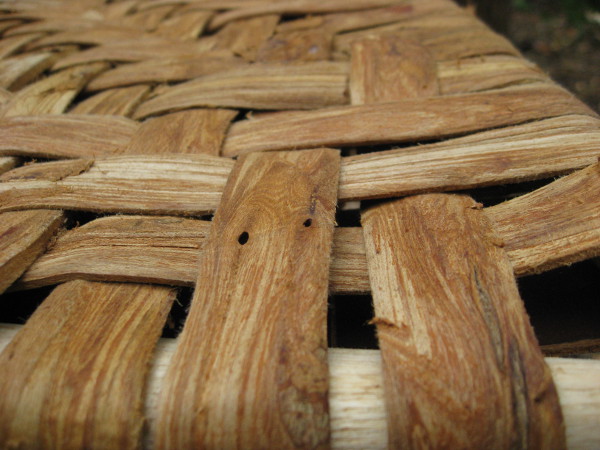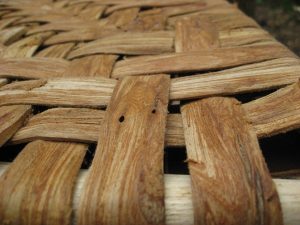“There is a curiously appealing and picturesque quality about rustic work. More than any other type of wood furniture or architecture, it seems to hold the spirit of the forest.” – The Craftsman, 1915
Contents
What is rustic furniture?
Rustic furniture is hand-made wooden household or garden furniture that is quick to make, using wood from trees in a natural state with a minimum of processing. Items retain the character and natural beauty of the tree they were made from.
Unless you want to sit, eat your meals and sleep on the floor (and there’s absolutely nothing wrong with that), you’re going to need furniture. With rustic furniture-making, each piece, whether it’s a chair, table, bench, stool, shelf or bed, is as totally unique as the tree it came from.

The techniques of rustic furniture-making are accessible to the complete novice. Pieces can be made using the most basic of hand tools, and are held together using rudimentary round mortice and tenon joints. Tenons are sometimes wedged into the mortice using little wooden wedges to hold the joint tight. Often though, rustic furniture is made from green (unseasoned) wood, and freshly-cut wood contains a huge quantity of water which evaporates, causing shrinkage. This can be of benefit in some joints, as shrinkage can produce a tight fit.

The green woodworking techniques involved in rustic furniture-making tend to follow the grain, resulting in increased strength, as the wood’s linear fibres remain intact. You can also leave the bark on, if you think it looks nicer. Any wood can be used for indoor furniture, but outdoor furniture tends to be made from oak or chestnut, as it’s more durable.
The history of hand-made furniture from natural materials stretches back to the origins of furniture making, traditional woodman’s crafts and smallholders’ DIY. Of course, in many parts of the world, furniture has always been, and still is made this way.
What are the benefits of rustic furniture?
Furnishing our homes can be very expensive. A major benefit of rustic furniture is that you can make your own very cheaply, if not for free. Making rustic furniture is joyfully simple. Pieces can be made using a modest selection of basic hand tools, which makes it accessible for anyone to make – you don’t have to have power tools or the experience (and power) required to use them. This also means that you can make your furniture in the woods where the tree has been felled.

Once you own some basic tools, the materials that you need will have a very low embedded energy, and hopefully won’t have been transported far. Your raw materials will be local, biodegradable, renewable, produced by solar energy, and during its lifetime will have provided a habitat for many creatures.
This type of furniture, as well as being beautiful and unique, will have potentially the lowest eco-footprint of any kind of furniture you could make or buy.

The alternatives are:
- mass-produced furniture from a superstore – probably from timber transported long distances, and possibly using glues and preservatives containing chemicals like formaldehyde, that will slowly emit toxic fumes and add to the chemical mix found in many modern homes.
- craftsman-made wooden furniture, which although beautiful and functional, is often very expensive, or requires a long apprenticeship to learn how to make.

When your rustic furniture wears out, or you want a change, you can quickly replace it, and turn it into firewood. This style of working means that you can use low-grade wood from non-timber quality trees – for example local coppiced wood, or wood harvested from gardens or estate management. This can often be free, or very cheap. But you can still use large, sturdy pieces of wood to make furniture that will last a lifetime.

What can I do?
First, get some tools. The basic hand tools needed for rustic furniture-making are the same as for any green woodworking project. These may include an axe, froe (splitting tool), draw-knife (shaving tool), rounder (rotary plane), a good wooden mallet (that you can make yourself) and a bow-saw. These can be obtained from a variety of places, some mainstream, some specialist. For example, new side-axes and other tools can be purchased online, or alternatively, good-quality second-hand tools can be found in second-hand shops or antique stores, or at wood fairs / festivals / markets.
In addition, a shave horse and/or pole lathe could be useful (although you can make good pieces without them). A shave horse is used with a draw-knife for shaping things like chair legs. A pole lathe is used for turning wood to make round objects, again – like chair legs. You can buy them from specialists, or make your own.
You have various options for upholstering your rustic furniture. Woven fabrics can be used for chair seats – such as sea-grass, tree bark or reeds, although often rustic furniture needs no upholstering. You can, of course, add cushions, mattresses, throws etc. You can choose to finish your furniture with various natural oils or stains, but often it will need no finishing at all.

You can learn how to make rustic furniture from books (see resources); but as it’s a practical skill, probably the best way is on a course. You can also buy rustic furniture – you could find suppliers through word of mouth if you’re lucky, or via an internet search, or you may come across people making rustic furniture in your area from local coppiced wood.

Your finished product can be as rough-and-ready or as well-crafted as you like, depending on taste, what it’s for, and how much time you are prepared to put into it. In theory you can produce any type of domestic furniture in this style. You are limited only by your imagination.
Specialist(s)
Thanks to Adrian Leaman of Wholewoods for information.
The specialist(s) below will respond to queries on this topic. Please comment in the box at the bottom of the page.

Adrian Leaman of Wholewoods helped Ben Law to build his Woodland House in 2002, and since then has been roundwood timber framing, particularly reciprocal roof roundhouse building, and sharing woodland and woodcraft skills with people from all walks of life. He is a Forest School Leader and works with adults and teenagers on educational projects.



2 Comments
Are there any courses to show people how to make rustic furniture?
Click on ‘courses’ under resources, and there’s a link in the article.